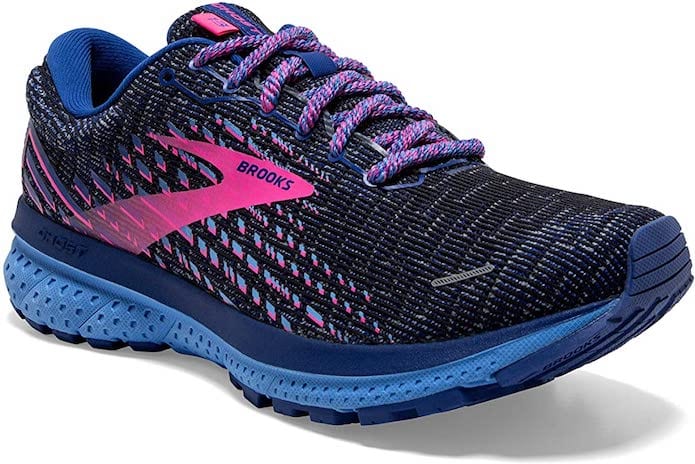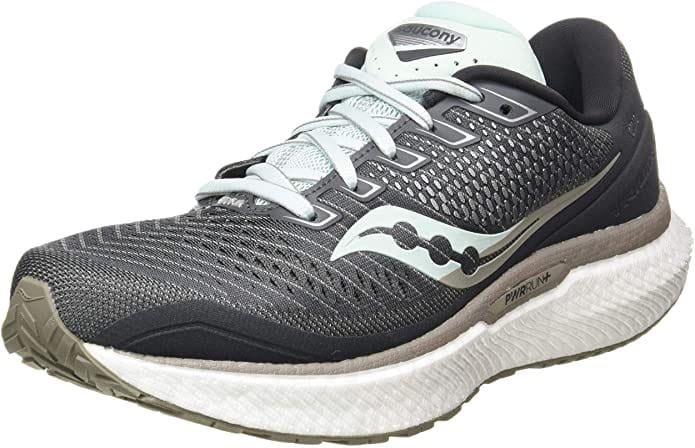What can you do to eradicate Shin splints forever? Get yourself the right pair of shoes! But where should you start? It can be daunting to sort through all of the available options, so we rounded up a list of the best running shoes for shin splints.
Whether you are a seasoned runner or training for your first race, you don’t back down from a challenge. You train before dawn, plan your routes perfectly, and are more intimate with your foam roller than you’d like to admit. This sport isn’t for the faint of heart, and we get it. You’re tough. But the one thing that will stop any runner in their tracks? Painful shin splints.
We have all been there. You’re training hard and upping your mileage considerably, then BAM! Just when you were getting into a groove, that dull, aching pain in your shin makes you wonder if this is even worth it.
Shin splints are one of the most common injuries plaguing runners. Don’t let this annoying pain keep you from doing what you love.
So, what are the best shoes for runners with shin splints? On your mark, get set, let’s go.

This workhorse of a shoe will achieve the goals of most runners. Although it’s predictable, don’t be fooled. This shoe is anything but basic.
The Rearfoot Gel cushioning technology provides a soft material directly under your heel and reduces the shock each time you strike the ground. The Gel-Nimbus 23 is famous for its cushioning, and the newest version has even more than before.
Because the model has so much cushioning, it’s slightly heavier than its competitors and could be clunkier than you’re used to.
If you are looking for a solid shoe that gets the job done, this is a great option.

Hoka shoes are known for their minimalist design and maximum performance. The Hoka Clifton 7 is no exception.
Hoka One One achieves the ideal balance between lightweight and cushion a supportive shoe needs to have to help you reduce the incidence of shin splints. You won’t find many pairs of running shoes that boast this much padding at a mere 8.7 ounces (men’s version).
The heel tab is engineered for easy on and off, so you won’t have to undo the laces when you’re beat from your workout. The light and breathable mesh keep your feet cool and comfortable.
Although it can last through the long miles, some distance runners find it difficult because it has so much cushioning.
The Clifton 7 is built for performance while providing optimum shock absorption.

Brooks’ most popular shoe has been around for 20 years and is a staple for a reason. This Brooks Adrenaline specifically focuses on runners with injury-prone knees, but the stabilizing features can help combat other ailments, like shin splints.
The reason the Brooks Adrenaline GTS 21 works is because it reduces unnecessary movement in other parts of your foot, leg, and body. The full toe-to-heel cushioning makes for a super smooth ride. The front portion is made from breathable mesh that hugs your foot for security while maintaining constant airflow.
Because the Brooks Adrenaline locks you in, you might need to go up a half size. Additionally, the secure heel is a bit bulky and can hinder the speed of faster runners.
All in all, the Brooks Adrenaline is a stability shoe that’s been tried and true and still one of the most popular running shoes on the market.

This all-terrain shoe was designed for trail runners. The toe box is made of synthetic leather for extra support. Similar to memory foam, the inside molds to the shape of your feet over time, making each run more comfortable than the last.
It’s quite a bit less expensive than the other shoes on this list, which could be attributed to its weight. The budget-friendly materials mean your feet might get hotter in the spring and summer months. Nonetheless, this strong shoe will keep your feet safe while you run rugged landscapes.
If you love to knock out miles in the great outdoors and want a comfortable ride, this shoe is for you.

The second option on our list from Brooks is your go-to, neutral shoe. The Brooks Ghost 13 is well balanced while also focusing on extreme cushioning. If you feel pain from the hard concrete, this shoe will keep your shins protected.
The extra plush DNA Loft Foam technology extends the entire length of the shoe. The material is supremely flexible but you will need to watch for durability. The outside rubber sole tends to erode faster than other shoes. Make sure you inspect it often and replace it before it gets too worn down.
Whether you’re a veteran or just getting into running, this all-around favorite is a great option.
SEE ALSO: Brooks Ghost 13 GTX

The New Balance 1080v10 is a fantastic shoe for distance runners. The rocker shape allows for maximum speed. As durable as they come, this running shoe is designed for high mileage. You likely won’t have to change it out before hitting the max of 500 miles (typically running shoes last 300-500 miles).
The heel features extra coverage that fits almost like a sock. This unique design hugs your ankles for the most secure fit.
The toe box is stiff and might take a while to conform to your feet, but if you can be patient, this shoe is worth it.
SEE ALSO: New Balance Fresh Foam 1080v11

Saucony’s most cushioned shoe will keep you pain-free on even your longest runs. Supremely plush, the padding was designed with comfort in mind. This neutral running shoe features a springy sole to give you that extra push to the finish line.
Though this isn’t the most lightweight shoe on the list, you cannot deny the Triumph 18’s luxurious feel. If only they spent more time on the lace design! The material frays quickly. No matter the distance, this shoe will keep your legs feeling great.

There a few things to focus on when you are trying to relieve yourself from shin pain.
First, you need a shoe with adequate cushioning. Besides the added comfort, the extra cushion will help absorb the shock from running on hard surfaces. Remember, keeping your heel strike in check is key to eliminating shin splints.
The durability of the shoe is what protects the supportive cushioning material and keeps your foot stable. It acts as a barrier between your foot and the trail, mud, concrete, rocks, etc.
The average pair of running shoes last 300-500 miles (3-6 months depending on your weekly mileage). While it is important to change your shoes regularly, you don’t want to be buying shoes more than you have to. They aren’t cheap! You need a shoe that lasts. The durability of the shoe is part of the investment, and you need to protect it.
Fit is probably the most important aspect of your running shoe. How well do you know your foot? What’s the shape? The size? The mechanics? You might not have thought beyond your shoe size before, and it’s time to start. Especially when it comes to shin splints, you need to understand your arches, muscles, and tendons and how they all work together.
Don’t buy ill-fitting shoes and then try to break them in. They should fit comfortably in the store. Remember that your feet swell when you run, so you should have plenty of space to wiggle your toes. Got a pair of lucky toe socks? Or a heel insert? Make sure you try those on with your new shoes before you go out for a long run.
Choose the type of support you need based on your foot type and biomechanics. If you are a runner with flat feet and overpronates, you should get a shoe with lower arch features, including a guide rail. The guide rail will help center your foot in the shoe and avoid excess movement.
High arched feet don’t flex as they should, so a runner needs a lot of support and cushioning.
Shin splints are caused by different reasons, and some are easier to fix than others. They could be caused by ill-fitting or old running shoes. Also, if you overpronate, you are at the risk of developing shin splints. Muscle imbalance and failure to stretch enough can result in shin splints when you run.
Running shoes won’t give you or cure you from shin splints on their own, but they do make a difference. If you have flat feet and are running in an inappropriate shoe, you are setting yourself up for injury. Running requires very little equipment – really, all you need is a pair of shoes and you’re ready to go. Since you don’t need much, go ahead and invest in a good pair of shoes. Your body will thank you!
Buying new shoes won’t completely solve shin splints, but it’s a great place to start. New shoes appropriate for your foot, training frequency, and personal needs can help correct running form and take the pressure off your shins.
We all know how hard it is to stop doing what you love. It seems like you’re doing great and then all of a sudden someone tells you to stop? It can be devastating news. Trust us, we get it. But it really is best to give yourself a break to heal. It’s tempting to keep going, but if you continue to push yourself, the pain will only worsen.
Even if you are training on a deadline, give yourself at least two weeks as a break. You can remain active with lower impact exercises like yoga, swimming, walking, and cycling as long as you don’t push it too hard. If you must continue to run, stick to the treadmill for a while.
Usually, runners get shin splints from going too hard, too fast and applying repetitive stress on the calf muscles. You can diminish the risk by following the 10% increase rule. You should never increase your weekly mileage by more than 10% of the previous week’s mileage. For example, if you ran 10 miles last week, you should not run more than 11 miles the following week.
Some other ways to stop getting shin splints are to always run on the same type of surface, keep your whole body conditioned with cross-training, stretch thoroughly and regularly and focus on shortening your stride.
Another great way of preventing shin splints is tracing the alphabet with your big toes on the floor to strengthen your shin muscles. Calf raises can also strengthen your shin muscles and prevent shin splints.
Compression socks help increase blood flow to the lower leg muscles. With more blood flow and oxygen getting to them, you have a lower chance of inflammation.
When it comes to shin splints, don’t be a hero. Toughing it out isn’t the answer. You need to fix the problem, or it will keep coming back. Running in pain is no fun. Starting with the right pair of shoes will have you back to enjoying your runs in no time.

Run Trails is an independent website created by trail running enthusiasts. The views expressed on this site may come from individual contributors and do not necessarily reflect the view of Run Trails or any other organization.